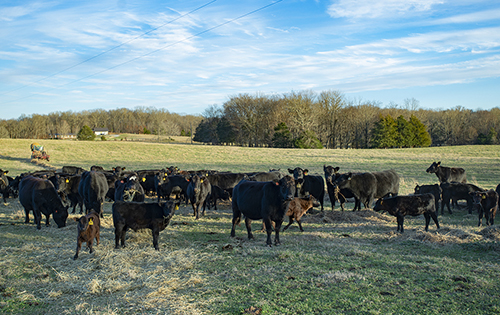Antibiotic Usage Tips
Jan 13, 2022

Animal health often declines in the winter months. This often leads to an increase in the usage of antibiotics in our animals. There are a few important things to remember when deciding how to use antibiotics.
First, you should consult your veterinarian. Even when using over-the-counter antibiotics, it is wise to get advice from your veterinarian. Very few antibiotics are over the counter (mostly penicillins and oxytetracyclines) and in late 2023, all antibiotics used in animal agriculture will transition to either Rx or Veterinary Feed Directive (VFD), it is wise to have a close relationship with a veterinarian who can both prescribe and give advice on antibiotics. Find a veterinarian that you can trust for advice on medications and more. Veterinarians can make recommendations such as which antibiotic to choose, duration of therapy, withdrawal times, and what medications are needed. Also, as a general rule, antibiotics with different mechanisms of action (bacteriostatic vs bactericidal) are not in combination with one another. There are a few exceptions to that rule, but a veterinarian can help you sort those concerns out.
Another important point to remember when deciding to use an antibiotic is withdrawal times. If there is a chance that the animal that needs to be medicated will enter the food chain, withdrawal times need to be considered. Withdrawal times for antibiotics are listed on the packaging, but it is important to remember that those times are for the antibiotic as it is labeled to be given. If for some reason, the antibiotic was given at a different dosage or a different duration of therapy, the withdrawal times will change. If the antibiotic is given to a species not on the label, the withdrawal time on the label may be dramatically different than the actual clearance of the antibiotic from the animal’s body. Veterinarians can make some recommendations for using medications off-label but withdrawal time changes must be addressed in food animals. There are some medications, however, that even a veterinarian is not allowed to make off label recommendations. That is another reason to have a great working relationship with a veterinarian who can help you understand important issues.
Historically, farmers have relied heavily on feed and/or water types of administration for obvious reasons, including ease of use. In recent years, this type of antibiotic administration has become more regulated. Feed through antibiotics now require a VFD for all antibiotics. The scope for which these antibiotics have also narrowed for most medications; most antibiotics are only labeled for therapeutic use and prophylactic/preventive use is prohibited. While these feed type antibiotics are still available from most feed stores, the farmer must have a VFD from their veterinarian in order to purchase the antibiotic.
Using antibiotics is certainly warranted in some situations, especially in the winter months. Remembering these basic points and cultivating a relationship with a veterinarian who can help with decisions surrounding the use of antibiotics will make antibiotic use more effective and efficient.
For more content like this, check out the latest issue of the Cooperator.
First, you should consult your veterinarian. Even when using over-the-counter antibiotics, it is wise to get advice from your veterinarian. Very few antibiotics are over the counter (mostly penicillins and oxytetracyclines) and in late 2023, all antibiotics used in animal agriculture will transition to either Rx or Veterinary Feed Directive (VFD), it is wise to have a close relationship with a veterinarian who can both prescribe and give advice on antibiotics. Find a veterinarian that you can trust for advice on medications and more. Veterinarians can make recommendations such as which antibiotic to choose, duration of therapy, withdrawal times, and what medications are needed. Also, as a general rule, antibiotics with different mechanisms of action (bacteriostatic vs bactericidal) are not in combination with one another. There are a few exceptions to that rule, but a veterinarian can help you sort those concerns out.
Another important point to remember when deciding to use an antibiotic is withdrawal times. If there is a chance that the animal that needs to be medicated will enter the food chain, withdrawal times need to be considered. Withdrawal times for antibiotics are listed on the packaging, but it is important to remember that those times are for the antibiotic as it is labeled to be given. If for some reason, the antibiotic was given at a different dosage or a different duration of therapy, the withdrawal times will change. If the antibiotic is given to a species not on the label, the withdrawal time on the label may be dramatically different than the actual clearance of the antibiotic from the animal’s body. Veterinarians can make some recommendations for using medications off-label but withdrawal time changes must be addressed in food animals. There are some medications, however, that even a veterinarian is not allowed to make off label recommendations. That is another reason to have a great working relationship with a veterinarian who can help you understand important issues.
Historically, farmers have relied heavily on feed and/or water types of administration for obvious reasons, including ease of use. In recent years, this type of antibiotic administration has become more regulated. Feed through antibiotics now require a VFD for all antibiotics. The scope for which these antibiotics have also narrowed for most medications; most antibiotics are only labeled for therapeutic use and prophylactic/preventive use is prohibited. While these feed type antibiotics are still available from most feed stores, the farmer must have a VFD from their veterinarian in order to purchase the antibiotic.
Using antibiotics is certainly warranted in some situations, especially in the winter months. Remembering these basic points and cultivating a relationship with a veterinarian who can help with decisions surrounding the use of antibiotics will make antibiotic use more effective and efficient.
For more content like this, check out the latest issue of the Cooperator.